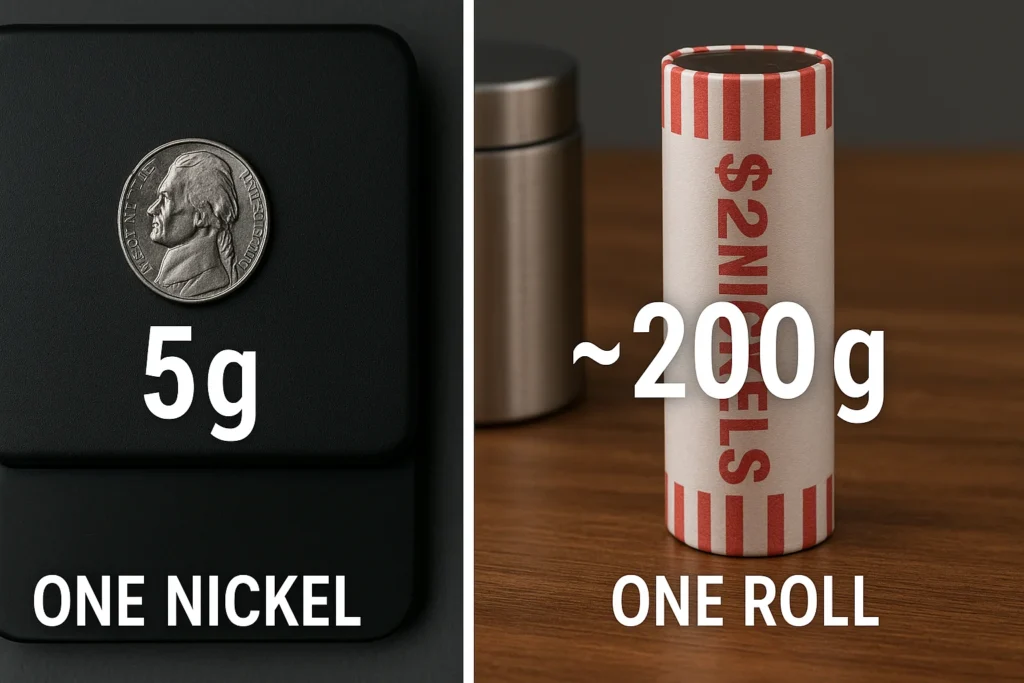A standard U.S. nickel weighs exactly 5 grams. This weight has been consistent since 1866.
In a Nutshell: How Much Does a Nickel Weigh?
- You will learn the exact weight of a U.S. nickel.
- You will understand what nickels are made of.
- You will find out how much a roll of nickels weighs.
- You will get tips on handling and collecting these coins.
Estimated reading time: 4 minutes
Do you often wonder about the small details of everyday items? Knowing how much a nickel weighs is more useful than you might think. It helps collectors, businesses, and anyone curious about U.S. coins.
The Exact Weight of a Nickel
A common U.S. nickel weighs precisely 5 grams. This weight has not changed since the coin first appeared in 1866. It helps keep all nickels the same. This makes them easy to use and count.

The U.S. Mint allows for a small difference in weight during making. A nickel can weigh between 4.806 grams and 5.194 grams. This small range accounts for normal changes in the minting process, as stated by the U.S. Mint specifications.
A simple tool to calculate the total weight of your nickels
Nickel Weight Calculator
Find out the total weight of your nickels.
What Are Nickels Made Of?
Modern U.S. nickels are made of two main metals. They are 75% copper and 25% nickel. This mix has been mostly the same since World War II. During the war, nickels were briefly made from other metals. This was due to a shortage of nickel. You can learn more about this history on Wikipedia.
The use of nickel in coins was new at first. But it became popular after a three-cent coin made of copper and nickel did well. Joseph Wharton, a businessman, helped push for nickel in the five-cent coin. He wanted the coin to be heavy enough to be sold at a good price. This helped his business.
Buy Gold Online: The Smart and Secure Way
Discover the safest and most reliable strategies to buy gold online. Make informed investment decisions and secure your financial future today!
Learn MoreNickel Statistics and Handling Tips

Knowing the weight helps with larger amounts of coins.
- Roll of Nickels: A standard roll holds 40 nickels. Since each nickel weighs 5 grams, a roll weighs about 200 grams. This is roughly 0.44 pounds.
- Many Rolls: If you have 10 rolls of nickels, they would weigh 2000 grams. That is about 4.4 pounds. This information is useful for banks or businesses handling large coin amounts, as noted by Accurate PMR.
- Storage: Keep your nickels in a good place. Avoid very hot or cold spots. Also, keep them away from too much moisture. Coin wrappers or special boxes are best for storage. This helps keep them in good shape.
- Store Properly: Keep nickels in coin wrappers or special boxes. This protects them from damage.
- Avoid Extremes: Do not store coins in very hot or cold places. Also, keep them away from damp areas.
- Handle Carefully: Touch coins by their edges if possible. Oils from your skin can harm their surface over time.
- Learn More: For valuable coins, research specific mint years and errors. Use trusted coin guides.
Collecting and Valuing Nickels
Nickels can be worth more than their face value. This is true for collectors. Rare nickels or those with special features can be quite valuable. They can be a good investment for coin collectors.
To find rare nickels, you should look up specific years they were made. Also, check for different designs or mistakes during production. Joining a local coin club can give you great tips. You can also use coin guides to help you identify and value rare coins. Websites like NGC Coin offer helpful resources.
Conclusion
Understanding how much a nickel weighs and what it’s made of is helpful. It gives you a better idea of its history and value. This knowledge is useful for collectors and for everyday use.
In-depth Discussion on the Topic:
Listen to Our Expert Panel
Your Questions About Nickel Weight Answered (Simply)
How much does a U.S. nickel weigh?
What is a nickel made of?
How much does a roll of nickels weigh?
Is the weight of a nickel always exactly 5 grams?
Why is knowing a nickel’s weight important?
When did the nickel first get its current weight?
Can old nickels be worth more than 5 cents?


